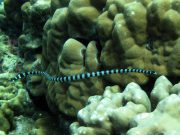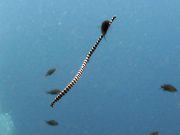Diving with Sea Snakes
Lanta Marine Life | Hydrophiinae
Sea snakes are a family of 69 venomous snakes which are found in warm coastal waters from the Indian Ocean to the Pacific and are closely related to venomous Australian land snakes.
Among this family are species with some of the most potent venoms of all snakes, and we can see one species in particular during Koh Lanta diving trips.
All sea snakes have paddle-like tails and many have eel-like compressed bodies that give them an eel-like appearance. Some species may be confused with the banded snake eel (Myrichthys colubrinus), however these can be differentiated by the shape of the head.
Unlike fish, they do not have gills and must surface regularly to breathe. however, one unique adaptation they have is their ability to absorb oxygen through the skin surface. Sea snakes can absorb up to 20% of their oxygen requirements through the skin and expire most of their carbon dioxide through the skin.
1 species found on this page:
Colubrine (Banded) Sea Krait
(Laticauda colubrina)
The yellow-lipped banded sea snake (Laticauda colubrina) is a species of highly venomous sea snake found in tropical Indo-Pacific oceanic waters, and at all of the dive sites around Koh Lanta.
The snake has 20 - 65 distinctive black stripes on a usually blue or blue-grey body and a usually (but not always) yellowish snout. These bands extend from the neck area to the tip of the paddle-like tail which is used for swimming. Adult males can reach 75 cm. Females are significantly larger than males, reaching 128 cm in length.

Female Laticauda colubrina @ Koh Bida
The banded sea snake spends much of its time underwater in order for it to hunt, but returns to land to digest, rest, slough skin, and reproduce. On land, the snakes drink fresh water.
These snakes primarily feed on varieties of eels, but also eat small fish. Adult males normally hunt in shallow water for small moray eels, and adult females normally hunt in deeper water for conger and garden eels They can hold their breath for long periods while they look for prey of eels and small fish, when they find some food they paralyze it through a bite and administer powerful venom. Despite often being much smaller than the eels they feed on, banded sea snakes swallow their prey whole, then return to land to digest their prey.
As with the sea turtles and other reptiles, the banded sea krait is oviparous, meaning it lays eggs that develop outside of the body. And just like the other reptiles, these snakes must come ashore to nest. A lesser known fact about the banded sea snake is that it exhibits 'philopatry' which means, just like with sea turtles, it will return to the same beach time and time again to digest, rest and lay eggs.
Mating occurs in the water whereby the male will 'chase' the female until he becomes entwined with her in order to mate. Females return to their 'home' beach to lay up to 10 eggs in a clutch, which they will deposit in a nest in a crevice or underneath ledges. The incubation period is 4 months, after which, the juvenile sea snakes will hatch and make their way to shallow water.
This species of sea snake is not aggressive, and only attacks when threatened. If they do bite, it is usually in self-defense when accidentally grabbed. Most sea snake bites occur when fishermen attempt to untangle the snakes from their fishing nets. An old wives tail is that their fangs are too small to bite a person but this is not true but with the fangs are only a few cm long it means that they would find it difficult to penetrate a thick wetsuit.
The banded sea snake is hunted by sea birds, sharks, some larger moray eels and some bony fish.
Diving with Sea Snakes around Koh Lanta
Scuba Diving & Snorkel Trips
If you'd love a chance to spot Sea Snakes on one of our daily high season diving trips from Koh Lanta then send us an email to info@diveandrelax.com.
Join our high season speedboat dive trips to some of Thailand's best dive sites and enjoy small groups, short journey times, with a focus on great personal service, safety and fun.
Not yet a certified diver? Learn to Scuba Dive on Koh Lanta with the 3 day SSI Open Water Diver course.
Book online to save 10% on dive trips and scuba courses on Koh Lanta.
Find Out More
Indo-Pacific Marine Life Guides
- Allen, G., Steene, R., Humann, P., DeLoach, N. (2003) Reef Fish Identification, Tropical Pacific. Jacksonville, FL., USA: New World Publications, Inc., ISBN 1-878348-36-1.
- Humann, P., DeLoach, N., (2010) Reef Creature Identification, Tropical Pacific. Jacksonville, FL., USA: New World Publications Inc., ISBN 978-1-878348-44-9
- Debelius, H. (2013) Indian Ocean Reef Guide. Frankfurt, Germany: IKAN - Unterwasserarchiv, ISBN 978-3-939767-52-7.
- Debelius, H. (2004) Nudibranchs and Sea Snails, Indo-Pacific Field Guide. Frankfurt, Germany: IKAN - Unterwasserarchiv, ISBN 3-925919-51-1
- Erhardt, H., Knop, D. (2015) Corals Indo-Pacific Field Guide. Frankfurt, Germany: IKAN - Unterwasserarchiv, ISBN 3-925919-69-4.
- Veron J.E.N., Stafford-Smith M.G., Turak E. and DeVantier L.M. (2016). Corals of the World


